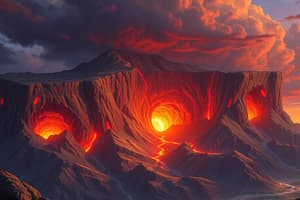Podcast
Questions and Answers
Which statement describes surface waves?
Which statement describes surface waves?
- They are the fastest seismic waves.
- They are produced by earthquakes.
- They are produced by P and S waves. (correct)
- They can travel through liquids.
Which statement describes how geologists use data from seismographs to learn about earthquakes?
Which statement describes how geologists use data from seismographs to learn about earthquakes?
- They analyze soil samples.
- They measure wind speed.
- They often compare information from all over the world. (correct)
- They only use local data.
Which phrase describes a feature of an earthquake's epicenter?
Which phrase describes a feature of an earthquake's epicenter?
- Location of the first observation.
- Region directly above the focus. (correct)
- Point of highest intensity.
- Subsurface point of origin.
The diagram shows circles drawn by geologists trying to determine the location of an earthquake's epicenter. What does each star on the map represent?
The diagram shows circles drawn by geologists trying to determine the location of an earthquake's epicenter. What does each star on the map represent?
Which statement describes the Mercalli scale?
Which statement describes the Mercalli scale?
Which factor does the moment magnitude scale estimate?
Which factor does the moment magnitude scale estimate?
What happens when stress builds at faults?
What happens when stress builds at faults?
Which statement describes the Richter scale?
Which statement describes the Richter scale?
Which statement describes the focus of an earthquake?
Which statement describes the focus of an earthquake?
How are S waves and P waves similar?
How are S waves and P waves similar?
Flashcards
Surface Waves
Surface Waves
Waves produced by P and S waves, traveling along the Earth's surface.
Seismograph Data Use
Seismograph Data Use
Geologists compare seismograph data from various locations globally to understand earthquake characteristics.
Earthquake Epicenter
Earthquake Epicenter
The area on the Earth's surface directly above the earthquake's focus.
Seismograph Location (Star)
Seismograph Location (Star)
Signup and view all the flashcards
Mercalli Scale
Mercalli Scale
Signup and view all the flashcards
Moment Magnitude Scale
Moment Magnitude Scale
Signup and view all the flashcards
Stress at Faults
Stress at Faults
Signup and view all the flashcards
Richter Scale
Richter Scale
Signup and view all the flashcards
Earthquake Focus
Earthquake Focus
Signup and view all the flashcards
S waves and P waves similarity
S waves and P waves similarity
Signup and view all the flashcards
Study Notes
Earthquake Terminology and Concepts
- Surface waves are a type of seismic wave created by both P (Primary) and S (Secondary) waves, traveling along the Earth's surface.
- Geologists analyze seismic data from various global sources to enhance their understanding of earthquakes.
- The epicenter of an earthquake is defined as the point on the Earth's surface directly above the earthquake's focus.
Seismology Practices
- Seismographs are essential tools in locating earthquakes; each star on the map indicates the position of a seismograph that recorded seismic activity.
- The Mercalli scale evaluates earthquakes based on the level of damage inflicted on structures and the intensity experienced by people.
Measuring Earthquake Magnitude
- The moment magnitude scale measures the energy released during an earthquake, providing an estimation of its overall strength.
- The Richter scale quantifies earthquake magnitude, indicating an increase as the potential for damage rises.
Faults and Stress
- When stress accumulates at geological faults, the surrounding rock can bend or fracture, leading to potential seismic activity.
- S waves (Secondary waves) and P waves (Primary waves) are both seismic waves that cause ground shaking during an earthquake.
Studying That Suits You
Use AI to generate personalized quizzes and flashcards to suit your learning preferences.




